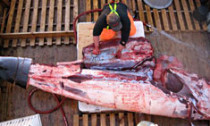
Whale hunters tend to shy away from publicity because of the controversy surrounding their profession. But the crew of the Jan Bjorn in Norway – a country whose fishermen kill around 500 minke whales a year for commercial purposes – agreed to let us join them on a hunting trip. Boom! The shock of the cannon judders through the old boat. It’s a hit. The minke is motionless maybe 30 yards away, the rope attached to the harpoon trailing in the water. The skipper, Jan, strains his small frame to haul in the catch. It does not give an inch. So Fred lends his considerable bulk to the task. He turns to me with a flicker of a grin.
“Now the work begins,” he says.
Fred is a paramedic by day. “Whaling is like a vacation,” he told me one afternoon as we sat in the crow’s nest, scanning the sea for tell-tale puffs of vapour. It was a beautiful day to be out in the fjords. There were no clouds to muzzle the ferocious mountains guarding the coast of Lofoten, in the far north of Norway, and no wind to ripple the water. Perfect weather for hunting whales. We had chugged on for hours without a sighting, giving me time to poke around the boat. At 15 yards long (13.7m), it was on the small side for a whaling vessel – just twice the length of its prey. It had been prowling these waters for 40 years, and looked tired. The rusty cannon had claimed a couple of Jan’s fingers a while back when it exploded as he attached the grenade.
“Oh, it’s not dangerous work,” he assured me, “accidents can happen in any job. The only problem is that I can’t cover the bass any more when I play the accordion.”
Jan is the easy-going sort. A lot of whalers would not have had a woman on board – it is considered bad luck. Fred was less comfortable with my presence. “Are you sure you’re not an activist?” he kept asking me. A couple of local boats were sunk some years ago in protest at the Norwegian government’s decision to resume whaling. It argued the industry was important for a community that has lived off the sea since Viking times.
Every whaler I met insisted whales were eating too many fish, leaving too few for them. Many wanted to be allowed to hunt bigger whales, and seals too. The fuss baffles them. Jan told me: “I was raised on a farm. We took care of the cows and the sheep and slaughtered them when it was time. For me it’s no worse to take the life of a whale than to kill an ox. Whale is food.”
That is a lot to take on board when you’ve been raised on a diet of anti-whaling protests. But it is only 50 years since Britain stopped whaling, and in the days after World War II, plenty of people were glad of the meat. I comforted myself the kill would be quick. Nine times out of 10, I had been told, the grenade detonated inside the whale’s brain, an instant death. Only, this day it was not going to plan. Three minutes had passed since the whale had been harpooned. For most of that time, it had been under the surface. Suddenly it lurched into view, revealing a deep gash in its back where the harpoon had passed right through. Only now did I realise that it was still alive and trying to swim. Fred grabbed the rifle just as the whale dived again. The boat was tense. Two long minutes went by before the whale reappeared and Fred could finish the job.
He turned to me grim-faced. “I want you to know, it almost never happens like this,” he said. The captain, Jan, took the blame – saying he misfired and was sorry it had happened. But these are practical men.
“This can happen in all kinds of hunting,” he told me. “If you shoot an elk, it might run into the forest and you don’t manage to kill it until the next day.”
Over the next few hours Fred was in charge of carving up the whale, known as flensing. I stroked it, its skin rubbed off on my fingers. Fred ripped off the blubber like Velcro. The stomach floated away like a beach ball, chased by seagulls. As he heaved the carcass into the water, Fred called out “thank you for the meat”. Eight steaks, a yard long, lay on the deck. They would earn each of the crew a few hundred pounds each. The meat is served rare, fried in butter and garlic. Or smoked, and eaten with crackers and sour cream. The locals go wild for it.
They may not get to taste it for very much longer. Young people in Lofoten are choosing to live in the cities so there is no-one to man the boats. Jan shrugs: “That’s natural. I’m 69 now. When I go ashore, this boat will be the last in the area.” I disembarked, reflecting how little there was of Moby Dick’s Captain Ahab in affable Jan and ambulance-driving Fred.
And how different the sea was from the slaughterhouse.











Social Profiles